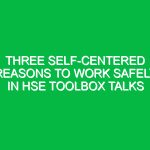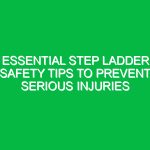Introduction
Slip, trip, and fall incidents are among the most common workplace accidents, accounting for a significant percentage of injuries across various industries. According to the National Safety Council (NSC), these incidents lead to thousands of injuries every year, and many result in time away from work. Understanding the dynamics of slip, trip, and Fall Hazards is crucial within the Health, Safety, and Environment (HSE) domain, where maintaining a safe workplace is paramount.
In this article, we will explore practical measures to prevent these Hazards, the importance of awareness, and the role of Regulations in fostering a safer work environment. By implementing essential Safety tips and fostering a culture of Safety, employers and employees can significantly reduce the likelihood of slip, trip, and fall incidents.
Understanding Slip, Trip, and Fall Hazards
Slip, trip, and fall accidents can occur due to various factors, including environmental conditions, employee behavior, and equipment usage. Here’s how they differ:
- Slip: This occurs when there is not enough friction between the footwear and the walking surface. Common causes include wet or oily floors, loose mats, or spills.
- Trip: A trip happens when a person’s foot contacts an object or an uneven surface, causing them to lose balance. Examples include cluttered walkways or uneven flooring.
- Fall: A fall is the result of losing balance and going to the ground. Falls can happen from heights or on the same level, often resulting in serious injuries.
These incidents are not only physically damaging but can also lead to emotional distress and financial burdens on both employees and employers.
Key Factors Contributing to Slip, Trip, and Fall Incidents
To effectively prevent slip, trip, and fall hazards, it’s essential to understand the key factors that contribute to these incidents.
Environmental Conditions
Work environments can vary significantly, leading to unique safety challenges. Common environmental hazards include:
- Wet or Slippery Floors: Spills, rain, or cleaning processes can create slick surfaces.
- Uneven Surfaces: Cracks in floors, loose tiles, or uneven carpets can create trip hazards.
- Inadequate Lighting: Poorly lit areas can obscure hazards and make navigation difficult.
Employee Behavior
Human behavior is a critical factor in Workplace Safety. Employees may overlook safety practices or rush through their tasks, leading to increased risk. Some common behaviors that can lead to slip, trip, and fall hazards include:
- Not Reporting Hazards: Employees may fail to report spills or hazards, allowing them to persist.
- Improper Footwear: Wearing inappropriate shoes can reduce traction and increase slip risk.
- Carrying Excessive Loads: Limiting visibility while navigating can lead to trips or falls.
Equipment and Maintenance Issues
Maintaining equipment and premises is essential to minimize risks. Equipment that malfunctions or is not properly maintained can contribute to hazards. For example:
- Poorly Maintained Walkways: Cracks, potholes, or debris can create trip hazards.
- Inadequate Safety Equipment: Lack of mats, handrails, or safety signage can increase risk.
Best Practices to Prevent Slip, Trip, and Fall Hazards
Implementing Best Practices is crucial in preventing slip, trip, and fall incidents. Here are essential tips to foster a safer work environment:
1. Conduct Regular Safety Audits
Regular safety audits help identify potential hazards. Involve employees in the audit process to encourage ownership of safety practices. Documentation of findings and corrective actions should follow to ensure transparency and accountability.
2. Maintain Clean and Dry Surfaces
Keeping work areas clean and dry is vital. Regularly inspect and clean floors to remove spills or debris. Use non-slip mats in areas prone to moisture, and ensure prompt cleanup of any spills.
3. Improve Lighting
Ensure that all work areas are adequately lit. Good lighting improves visibility and allows employees to see potential hazards before encountering them. Regularly check light fixtures and replace bulbs as needed.
4. Implement Proper Training Programs
Training plays a crucial role in preventing slip, trip, and fall incidents. Employees should receive training on recognizing hazards, proper footwear, and safe work practices. Regular refresher courses can reinforce safety awareness.
5. Encourage Reporting of Hazards
Create a culture where employees feel comfortable reporting hazards without fear of retribution. Implement a straightforward reporting system that ensures prompt action is taken to address reported issues.
6. Use Appropriate Footwear
Encourage employees to wear appropriate footwear that provides adequate traction and support. Consider providing guidelines on acceptable footwear based on the work environment.
7. Install Safety Equipment
Strategically place handrails, anti-slip mats, and signage to enhance safety. Ensure that safety equipment is regularly inspected and maintained to remain effective.
Real-Life Examples and Case Studies
Understanding the impact of slip, trip, and fall incidents through real-life examples can underscore the importance of preventive measures.
Case Study 1: A Manufacturing Facility
In a manufacturing facility, an employee slipped on a wet surface that had not been marked with warning signs. The resulting injury led to a significant loss of work time and incurred medical costs. After this incident, management implemented a more rigorous cleaning schedule and placed visible signage in high-risk areas. This proactive approach reduced slip incidents by over 50% in the following year.
Case Study 2: A Retail Environment
A retail employee tripped over a loose mat that had been reported by coworkers multiple times. The failure to address this hazard resulted in a serious injury. Following this incident, the company revised its hazard reporting protocols and initiated regular checks of equipment and surfaces by management. This change not only improved safety but also boosted employee morale.
Regulations and Standards
Several regulations and standards govern slip, trip, and fall safety in the workplace. The Occupational Safety and Health Administration (OSHA) outlines specific requirements for maintaining safe working conditions, including:
- osha Standard 1910.22: This standard requires employers to keep walking-working surfaces clean and orderly.
- OSHA Standard 1910.23: This standard addresses safeguards for floor openings, including the need for guardrails.
Understanding these regulations is crucial for employers to mitigate risks and ensure compliance. Regular training on these standards can help create a safer workplace.
Conclusion
Preventing slip, trip, and fall hazards is an essential aspect of maintaining a safe and productive work environment. By understanding the risks, implementing Best Practices, and adhering to regulations, organizations can significantly reduce the occurrence of these incidents.
Fostering a culture of safety, where all employees are aware of their role in preventing slip, trip, and fall hazards, is vital. As we strive for a safer workplace, let’s remain vigilant and proactive in our efforts. Remember, safety is a shared responsibility, and every small action counts in creating a safer work environment.


